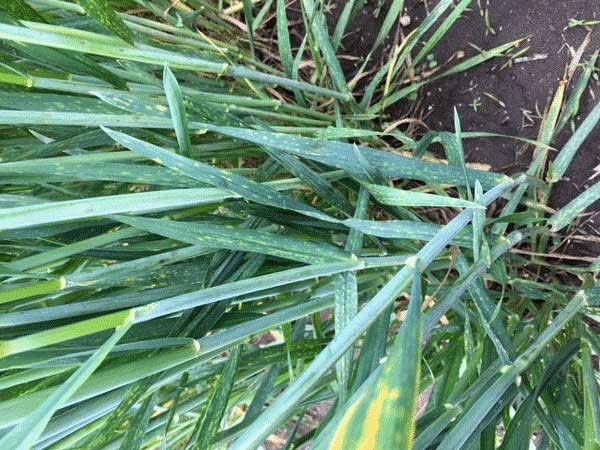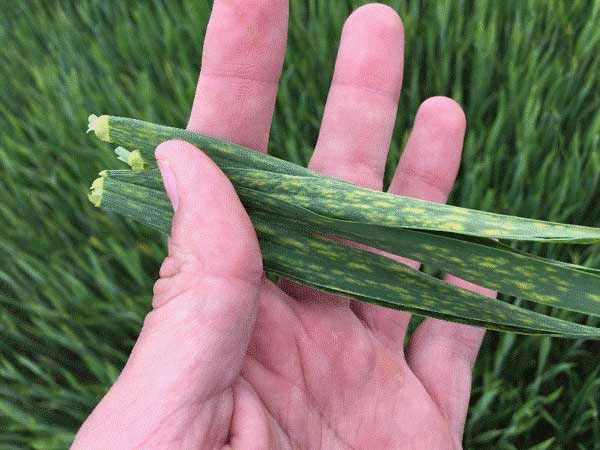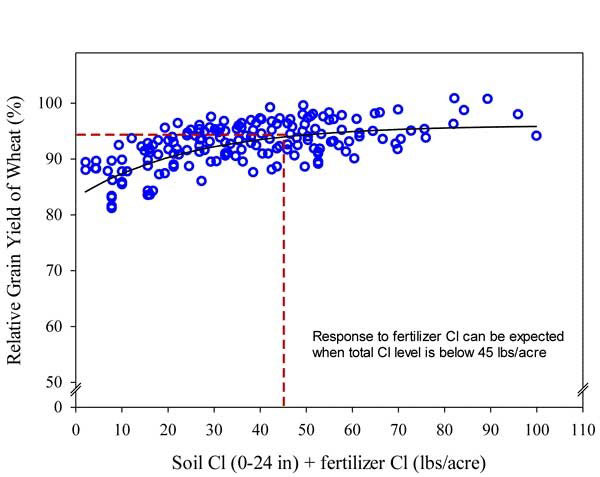Chloride (Cl) is a highly mobile nutrient in soils and topdressing is typically a good time for application, especially in regions with sufficient precipitation or with coarse-textured soils are prone to leaching.
One of the main benefits from good Cl nutrition is the improvement in overall disease resistance in wheat. Wheat response to Cl is usually expressed in improved color, suppression of fungal diseases, and increased yield. It is difficult to predict whether Cl would significantly increase wheat yields unless there has been a recent soil test analysis for this nutrient. Chloride fertilization based on soil testing is becoming more common in Kansas.
As with nitrate and sulfate, Cl soil testing is recommended using a 0-24 inch profile sample. Based on current data, the probability of a response to Cl in dryland wheat production in northeast and central Kansas seems higher than in western Kansas.
The interpretation of the Cl test and corresponding fertilizer recommendations for wheat are given in the table below. Chloride fertilizer is recommended when the soil test is below 6 ppm, or 45 pounds soil chloride in the 24-inch sample depth. Dry or liquid fertilizer sources are all plant available immediately. Potassium chloride (potash) and ammonium chloride are commonly available and widely used fertilizer products, though other products such as calcium, magnesium, and sodium chloride can also be used and are equal in terms of plant availability.
Table 1. Soil test chloride interpretations for wheat in Kansas
|
Soil Chloride in a 0-24 inch sample |
Chloride Recommended |
||
|
Category |
(lbs/acre) |
(ppm) |
(lbs Cl/acre) |
|
Low |
<30 |
<4 |
20 |
|
Medium |
30-45 |
4-6 |
10 |
|
High |
>45 |
>6 |
0 |
Chloride deficiency symptoms appear as leaf spotting and are referred to as physiological leaf spot.


Figure 1. Upper and lower photos both depict chloride deficiency symptoms (physiological leaf spotting) in wheat. Photos by Dorivar Ruiz Diaz, K-State Research and Extension.
K-State has done considerable research on Cl applications to wheat since the early 1980’s, mostly in the eastern half of the state. Results have been varied, but there have been economic yield responses in almost all cases where soil test Cl levels have been less than 30 lbs per acre (Figure 2).

Figure 2. Relative wheat grain yield as affected by total chloride supply (soil + fertilizer) in Kansas.
Deficiencies were most likely to be found on fields with no history of potash (KCl) applications. Recent studies showed that there are variety differences in response to Cl and are likely associated with the tolerance of that variety to fungal diseases.
For more information, please refer to the KSRE publication Chloride in Kansas: Plant, Soil, and Fertilizer Considerations, MF2570: www.ksre.ksu.edu/bookstore/pubs/MF2570.pdf
Dorivar Ruiz Diaz, Nutrient Management Specialist
ruizdiaz@ksu.edu